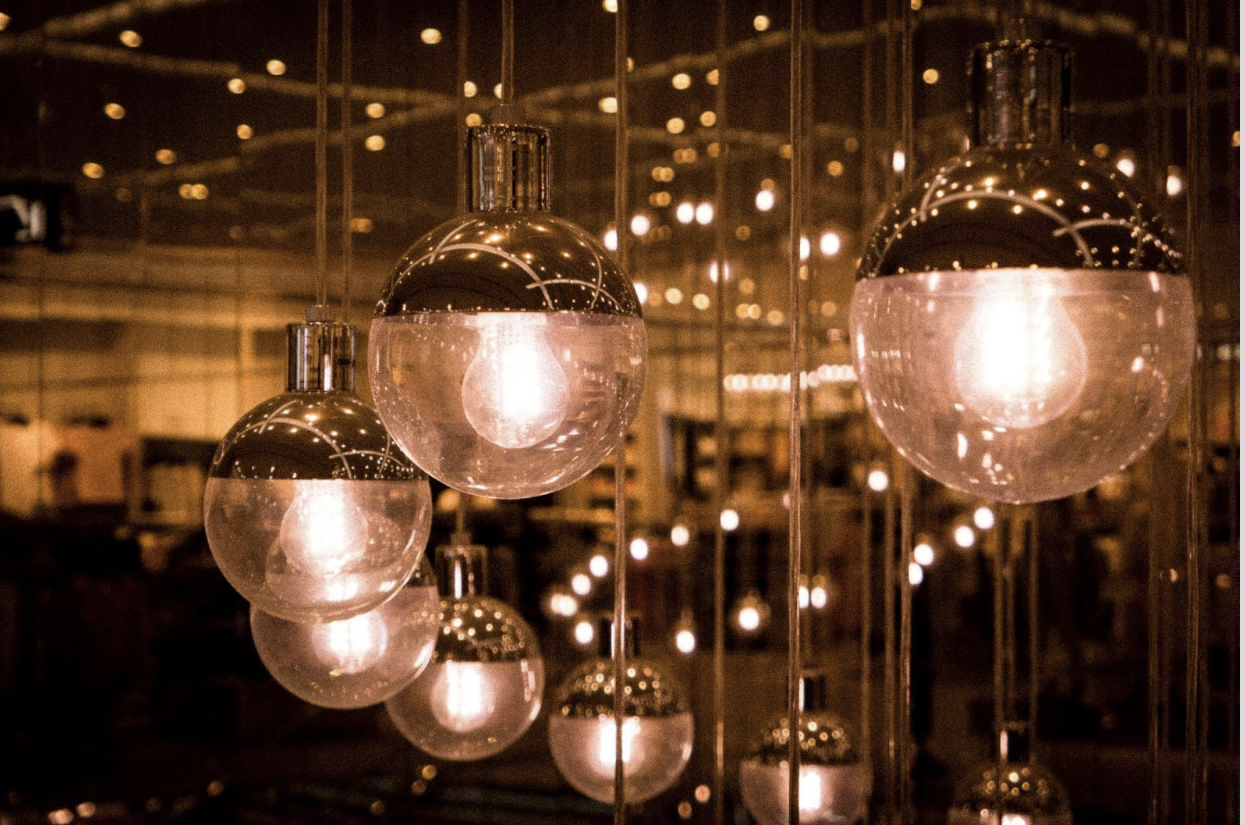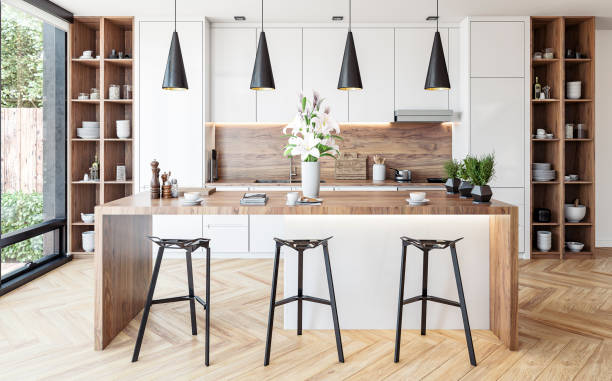Lighting is not just a practical necessity in our homes; it’s a powerful tool for shaping our living spaces and evoking specific emotions. From the warm glow of a bedside lamp that creates a cosy reading nook to the soft illumination of a dining room chandelier that sets the mood for an intimate dinner, lighting plays a pivotal role in how we experience our living environments.

Let’s delve into this shining world of home lighting, exploring how it can be used to enhance the ambience of your living spaces. Whether you’re looking to infuse a sense of calm into your bedroom, make your kitchen a vibrant hub of activity, or create a dramatic focal point in your living room, lighting can be your secret weapon in realising your vision.
The Art of Creating Specific Ambience through Lighting
Ambience refers to the emotional atmosphere or mood of a space. It’s how a room feels when you enter it, and it’s shaped by a variety of factors, with lighting being one of the most influential.
Ambience can vary from room to room and from moment to moment, depending on the desired effect. It can be the soothing feeling of a softly lit bedroom, the vibrant energy of a well-lit kitchen, or the romantic allure of a dimly lit dining area. Creating the right ambience through lighting is an art that combines science, design, and a touch of personal flair.
The Emotional Impact of Lighting
Lighting has a profound effect on our emotions and behaviour. Bright, cool lights can make us feel alert and energised, while warm, soft lighting can promote relaxation and intimacy. Understanding how different types of lighting affect our feelings is key to crafting the right ambience.
Balancing Functionality and Emotions
Effective lighting design strikes a balance between functionality and aesthetics. While quality designer lights should meet the practical needs of a space, such as providing adequate task lighting for reading or cooking, they should also enhance the overall atmosphere.
Customisation and Flexibility
One of the beauties of illumination is its versatility. With the right fixtures, bulbs, and controls, you can customise and adapt the lighting in a room to suit various occasions and moods. This flexibility allows you to transform a space with the flip of a switch or the adjustment of a dimmer.
Layering Lighting: Crafting the Perfect Look
Creating the right ambience in your home involves more than just flipping a single light switch. It’s about using different layers of light to build the perfect atmosphere for any occasion. Think of it as adding layers to your favourite outfit to create a complete and stylish look.
Ambient Lighting – The Base Layer
This is your starting point, like the main colour in your outfit. Ambient lighting gives a room a general illumination. It’s usually achieved through ceiling-mounted fixtures like chandeliers, recessed lights, or flush-mounted fixtures. The goal is to evenly light up the space without harsh shadows.
Task Lighting – The Functional Layer
Just as you might add a belt or accessory to your outfit, task lighting serves a specific purpose. It’s a focused light that helps you do things like read, cook, or work. Task lighting can include desk lamps, under-cabinet lights, and pendant lights over a kitchen island. It adds practicality to the overall ambience.
Accent Lighting – The Stylish Touch
This is like adding jewellery or artwork to your outfit – it’s all about style and attention to detail. Accent lighting is used to emphasise certain features, objects, or architectural elements in a room. You can achieve this with track lighting, wall sconces, or picture lights. It adds depth and drama to your space.
Dimmers – The Versatile Accessory
Think of dimmers as the volume control for your lighting. They allow you to adjust the intensity of your lights, creating different moods for various occasions. Dimmers can be added to both ambient and task lighting, giving you flexibility in setting the right ambience.
Colour Temperature and Its Impact
Have you ever noticed how the colour of light can affect the way you feel in a room? This is where colour temperature comes into play. It’s a concept that might sound a bit technical, but it’s actually quite simple and has a significant impact on the ambience of your home.
Colour temperature describes the warmth or coolness of the light emitted by a light source, usually measured in Kelvin. The lower the Kelvin value, the warmer and more yellow the light appears. Higher Kelvin values result in cooler and bluer light. Here’s what you need to know:
- Warm lighting: Think of candlelight or a cosy fireplace. They create a soothing and intimate atmosphere, perfect for relaxation and unwinding. Their warm, comforting glow falls in the range of around 2200K to 3000K. Such warm lighting is ideal for bedrooms or living rooms if you want to create a relaxed and inviting atmosphere.
- Neutral lighting: It’s neither too warm nor too cool, settling between 3000K and 4500K. Neutral lighting strikes a balance between comfort and productivity, making it versatile for various spaces. It’s often used in kitchens, bathrooms, and workplaces where you need good visibility and a welcoming atmosphere.
- Cool lighting: Cooler lights, with a Kelvin value of 4500K and above, have a crisp, bluish-white appearance. It’s reminiscent of daylight and is great for areas where you need to stay alert and focused, like offices or task-oriented spaces.
When selecting lighting for your home, consider the function and mood you want to achieve in each room. For instance, you might opt for warm lighting in the bedroom to create a soothing environment, but choose cooler lighting in the kitchen to enhance visibility while cooking.
Practical Tips for Choosing the Right Lighting Options
With a grasp of the various aspects of lighting, here are some hands-on suggestions to guide you in crafting the ideal ambience within your home:
- Match lighting to activities: Consider the actions that take place in each room. Use task lighting for work areas, warm lighting for relaxation, and cooler lighting for specialised spaces.
- Layer your lighting: As discussed earlier, layering lighting with ambient, task, and accent lights adds depth and versatility to your spaces. Use dimmers to control each layer effectively.
- Consider bulb types: Choose the right type of bulb for your fixtures. LED bulbs are energy-efficient and come in various colour temperatures, while incandescent bulbs usually emit warmer light but are less energy-efficient.
- Use lighting to highlight: Use accent lighting to draw attention to artwork, architectural features, or decorative elements in a room. It can help make a statement and add character.
- Pay attention to placement: Properly place fixtures to avoid glare and shadows. Wall sconces, for example, can help distribute light more evenly than overhead fixtures alone.
- Experiment and personalise: Don’t be afraid to experiment with different lighting setups. Your home’s ambience is a reflection of your personal style, so feel free to adjust and customise until it feels just right.
Conclusion
From the subtle nuances of colour temperature to the art of layering lighting, every aspect of home lighting is vital in transforming your rooms into a versatile canvas for your desired mood and functionality. Whether you seek a soothing sanctuary for relaxation, an energised space for productivity, or a blend of both, thoughtful lighting design is your ticket to achieving the perfect ambience.
Remember that the power of lighting lies not only in the fixtures and bulbs you choose but also in how you control and personalise them. Embrace dimmer lighting control systems, and don’t hesitate to experiment with different combinations to discover the unique settings that resonate with you.
Let your creativity shine as you illuminate your living spaces, creating experiences and memories that will forever be etched in the warm, gentle glow of thoughtfully designed light.
Published by HOLR Magazine.


